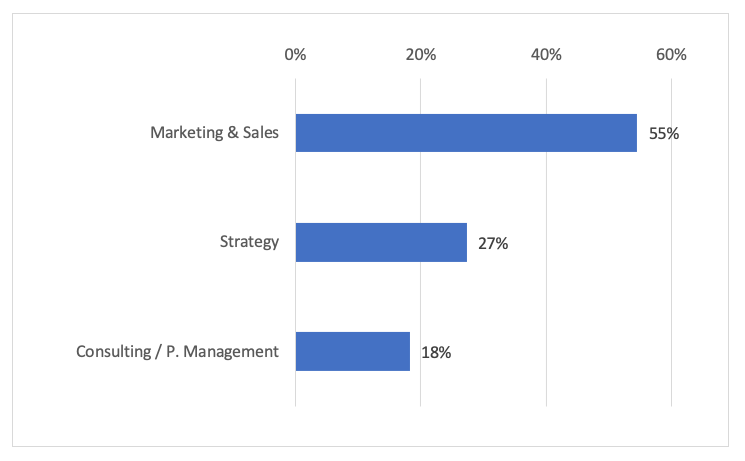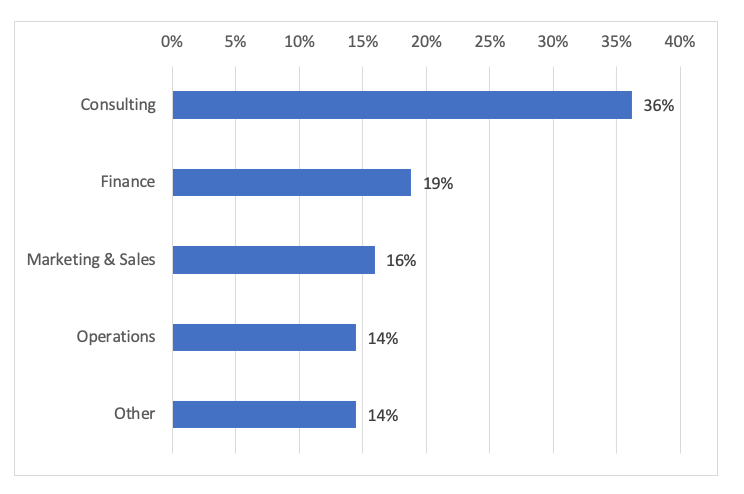Blocked pipeline: the career trajectory of women in strategy leadership
A study in Brazil shows how management consulting's gender gap affects the leadership ranks in strategy.

By David Kallás, Carlos Caldeira, Fabiana Cherubim Bortoleto, and Regina Madalozzo
The discussion of “fair” participation of female professionals in the workforce has been a hot topic in business literature and practice. Several large enterprises, such as Santander, Uber, PWC and McKinsey, to name a few, are putting policies in place to tackle gender inequality. The issue, however, seems to go beyond representation.
The following table shows some of the barriers that women face in their career progression, based on a literature overview.
| Phenomenon | Explanation |
|---|---|
| Representation | In several industries, women are underrepresented. In general, women are overrepresented in lower-paying industries. |
| Pay Gap | When controlled for time in the job, skill and other considerations, women earn from 5% to 7% less than comparable men. |
| Glass ceiling | Women are especially underrepresented in the upper echelons of organizations, from corporations to public administration and politics. |
| Glass elevator | Men tend to have a faster career progression than that of comparable women. |
| The labyrinth (trajectory) | To cope with the above difficulties, women tend to have less "straightforward" careers than men, looking for unusual paths to overcome obstacles. This usually translates in careers in HR or Marketing for women that are able to ascend to upper echelons. |
| The skills and style dilemma | Female managers face the constant struggle between following their own managing style and emulating the "male style". |
Source: Authors’ analysis of relevant literature
Our team conducted research aiming to understand the practice of strategy in Brazil. We were able to gather 80 executive-level respondents from organisations with annual revenues in excess of BRL 1 billion (approximately US$ 250,000) in different industries. We didn’t observe all of the phenomena cited above, but we have confirmed some of them in our sample.
Our research focused primarily on the career trajectories, skills and functions of strategy executives of corporations operating in the country. Even though gender was not part of our initial focus, we inevitably encountered the gender dimension as an important factor in the responses we received. The answers of the female executives were in contrast with those of their male colleagues.
First, while time in each career position is equal for both women and men (2.25 years vs 2.46 years) the number of promotions within are different: men are promoted 3.59 times and women 2.25. This difference could be explained by factors like age, pregnancy, marriage, or it could be an issue for our sample.
The study reveals a clear gap in gender representation. While the number of women in managerial positions is estimated to represent 39.9% of managers in Brazil (International Labour Organization and and World Bank), our sample had less than 15% of female respondents.
Career trajectory appears to be an important factor in explaining women’s low representation. First, the most important starting point for the executives in our sample was management consulting. While 36% of our male respondents have at one point worked for a consulting firm, just 9% of the female executives have done so (Accenture, Booz Allen, Strategy& and Mckinsey were the most popular consultancy employers). This is consistent with the representation of women in consulting. The “boys’ club” culture in consulting seems to be a key mechanism, one of the main cultural changes professional firms such as PWC and McKinsey are trying to establish.
The gender difference in career trajectories was also present when considering industries other than consulting. The numbers revealed very different paths for men and women. Besides consulting, men were able to explore jobs in finance, marketing and sales, operations and other choices. Women stuck mainly to marketing and sales. Interesting enough, several female executives have always worked in strategy, an unimportant trajectory for men in our sample.

Figure 1. Trajectories for women

There was also a difference in the skills that men and women perceived as the most important for performing their jobs. We presented all respondents with a list of skills for the position of CSO (chief strategy officer), as proposed in a classic study by Breene, Nunes and Shill (2007). We then asked them to rank these skills from the most to the least important.
| Skill | Description | Women | Men |
|---|---|---|---|
| Objective | Given their wide remit, CSOs have to be perceived as objective. An openly partisan CSO, or one who lets emotions, or the strength of others’ personalities, cloud his or her vision, is sure to fail. | #1 | #7 |
| Influencers, not dictators | Strategy chiefs don’t usually accomplish their goals by pulling rank. They sway others with their deep industry knowledge, their connections throughout the organisation, and their ability to communicate effectively at all levels of the company | #2 | #1 |
| Doers | CSOs split their time almost evenly between strategy development and execution, buttheir bias is towards the latter. CEOs are looking for a leader who can help implement it, not just refine it | #3 | #6 |
| Comfortable with ambiguity | The role tends to evolve rapidly, as circumstances dictate, requiring an extraordinary ability to embrace an uncertain future. | #4 | #3 |
| Jacks of all trades | Have significant line-management and functional experience in disparate areas, including technology management, marketing and operations | #5 | #5 |
| Guardian of horizon 2 | Senior teams generally have a good handle on short- and long-term issues. The medium term, that period from one to four years out, can fall through the cracks, however. CSOs must be able to refocus the organisation’s attention on horizon two, the critical period for strategy execution | #6 | #4 |
| Trusted by the CEO | CSOs are often given carte blanche to tackle companywide challenges and seize new business opportunities, so there must be a strong bond of trust between the strategy chief and the CEO. A long professional and personal history between them isn’t absolutely necessary — but it helps. | #7 | #2 |
| Multitasking masters | CSOs are responsible for upward of ten major business functions and activities, as diverse and demanding as M&A, competitive analysis and market research, and long-range planning. CSOs therefore must be capable of switching between environments and activities without losing speed. | #8 | #8 |
| Star players | They’ve achieved impressive business results earlier in their careers. They view the strategy role as a launching pad not a landing pad | #9 | #9 |
Source: Team analysis based on Breene, Nunes & Shill (2007)
The differences in preference among men and women were “illustrative”. Being objective stands first for women, and seventh for men. The data seem to corroborate the managing style dilemma seen in Table 1. While a man can follow his own, “male”, style of managing, a woman is frequently haunted by stereotype: “Can she be an efficient manager and continue to have a ‘feminine’ style?” Women gave little value to the quality of being deeply trusted by the CEO, while men ranked it second. Perhaps the “boys club culture” from consulting has carried over to the strategy practice.
In summary, the issues of women’s representation, trajectory and skills/style seem to have been replicated in strategy management practice. Even worse, the gender diversity issues in management consulting seems to have been translated somehow to strategy. It is far from good news. Management consulting firms are still in their first steps of gender representation. If consulting continues to be the primary pathway to becoming a strategy professional, it could take even longer for the gender representation shift to take effect in other industries.
Notes:
- The research reported was carried out at INSPER, Center for Business Studies, and supported by the Brightline Initiative.
- Article originally published on the LSE Business Review, on 09 March 2020
David Kallás is a professor and director of the Center for Business Studies at Insper, São Paulo, Brazil. He also teaches in the School of Medicine at Faculdade Israelita de Ciências da Saúde Albert Einstein. David is the author of four books and articles on strategic management published in national and international outlets. He is a parter at KC&D Consulting in Brazil, and vice president of Anefac, the Brazilian association of executives in business, accounting and finance. He has a PhD in strategy from Fundação Getúlio Vargas (FGV), São Paulo.
Carlos Caldeira is a partner at KCD Consulting and a part-time professor at Insper. Carlos has an M.B.A. from New York University and has a PhD in strategy from Brazil’s Fundação Getúlio Vargas (EAESP/FGV). He has extensive advisory experience, having worked at Ipsos, Booz-Allen, other consulting firms. He also has previous professional experiences at Ford, ABN Amro and Citibank. His research focuses on strategy, political strategies and customer experience. He has published in peer-reviewed journals and has co-authored two chapters about strategy execution in the book Administração Estratégica (2019).
Fabiana Cherubim Bortoleto is a research support specialist at Insper, and a PhD candidate in business administration at the School of Economics, Business Administration and Accounting at the University of São Paulo (FEA / USP). Her main interests are corporate governance, social responsibility, earnings management, strategy and cooperatives.
Regina Madalozzo is an associate professor at Insper, where she has written extensively on labour economics (wage differences and compensation) and household economics. Her current research is focused on women’s advancement at work, which is also a topic of her corporate lectures. Regina coordinates the Gender Studies Working Group of the Center for Business Studies at Insper. She has a Ph.D. in economics from the University of Illinois at Urbana-Champaign in 2002.